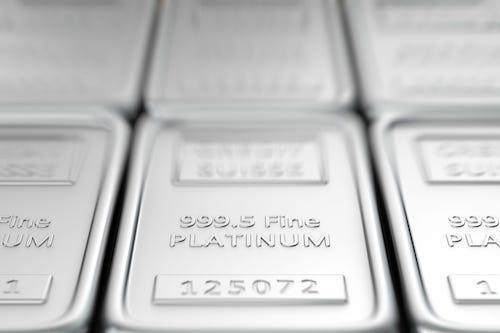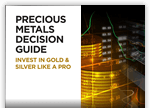
What‘s Happening with PGMs as Palladium Price Powers Past Platinum?
October 20, 2017
190 view(s)
Not so long ago it was unthinkable that the palladium price would exceed that of platinum given the comparative rarities of the two metals and their similar usages. But now the unthinkable has occurred and the palladium price has powered ahead of that of platinum. Indeed if current trends continue – the palladium price has risen around 36% year to date whereas, if anything, the platinum price has been flat to down a percent over the same time period – palladium could well extend its price advantage in the days, weeks and months ahead.
Platinum and palladium have similar properties and for both their prime markets nowadays are in the manufacture of automobile exhaust emission control catalysts. This has been a major growth sector as global automobile sales increased – notably in Asia – and gasoline and diesel vehicle pollution control legislation around the world has been tightened rigorously.
Initially it was platinum which took pride of place in the emission control catalyst market, but at the time it was also considerably more costly than palladium which led to a substantial amount of research into using the latter less costly metal in its place. This research was very successful leading to palladium mostly replacing platinum as the metal of choice in emission control catalysts for gasoline powered internal combustion engine vehicles. Platinum still proved more effective in diesel engine exhaust catalysts which kept it in good stead, particularly in Europe, as the more efficient diesel engines were beginning to take an ever-increasing share of the automobile market, but recently environmental concerns over diesel exhaust emissions, coupled with the Volkswagen scandal over testing manipulation have started to put a major dent in this market, which has led to a comparative fall in demand for diesel in the European markets in particular. With some cities around the world looking to ban diesel engined vehicles altogether, this decline in platinum demand (or lack of growth) has adversely affected the platinum market, while palladium demand has been exceeding supply for several years now.
Even so, the World Platinum Investment Council (WPIC), in its latest supply and demand analysis, paints a more positive picture for platinum than its 2017 price performance might suggest. It sees a market in balance, but with potential supply restraints ahead.
Relatively low platinum prices are already leading to mine closures and cutbacks in South Africa, far and away the world’s largest producer of the metal, where a number of mining operations are said to be uneconomic at current prices. This will also have a negative impact on new mine construction as well. The WPIC also points to the development of cleaner diesel engines, notably by Daimler in Germany, which has been attacking the worrying NOx emissions generated by diesel engines, although this may be too little too late with anti-diesel legislation already being implemented in some countries.
It also reckons that the impact of electric vehicles on likely platinum demand is likely being overstated. Overall the WPIC sees a 2% fall in supply in 2017, and a slightly bigger fall in demand which, it reckons, will leave the market in a very small deficit.
 Returning to the palladium sector, the supply/demand balance is reckoned to be over 1 million ounces this year, and this has been the key to the metal’s strong price performance. In a 10 million ounce market a 1 million ounce plus deficit is very significant indeed! Obviously there had been some major palladium stocks out there which had helped maintain sufficient supply to satisfy the market, and although the supply/demand imbalance in prior years had been noted by analysts, the price had failed to advance significantly – until the current year. Presumably the supply/demand situation is now meaning that palladium is at last seen as in substantial short supply and prices are being bid up accordingly as available excess stocks are diminished.
Major bank analysts feel that the palladium price advantage won’t last, but this writer disagrees. They have virtually all been hugely wrong in their palladium price predictions for the current year already. The palladium price advance so far in 2017 has been consistently strong and if the uptrend continues the metal price could reach $1,000/ounce, or higher, before the year end, with the platinum price only perhaps moving at best with that of gold and the overall precious metals complex. On current performance palladium could thus rise around a further 10-12% which would put it at well over $1,000, while gold, on the more optimistic predictions would only likely rise 7-8% which, if platinum follows suit, would only put the latter at say $990. So far this year it should also be recognized that platinum has underperformed gold and given its supply and demand are pretty well in balance the price may not advance much above current levels.
Palladium, though, is in a significant supply/demand deficit – some estimates put this at rising to close to 2 million ounces - and this is unlikely to improve in the foreseeable short to medium term. The long term prospects for both platinum group metals may be impacted adversely by the likely rapid growth in electric vehicle (EV) production, but this is unlikely to have an important impact until early in the next decade and while we suspect EVs will dominate the automobile market by the 2030s onwards, part of this impact will be in hybrid gasoline/electric cars which will still require palladium exhaust emission control catalysts.
The kind of price differential which may eventuate between palladium and platinum, if sustained, is unlikely to be sufficient to warrant any short term switch back to the latter for gasoline exhaust emission catalysts. So we do see palladium maintaining its advantage over platinum in the short to medium term. There may be a knee-jerk recovery in the platinum price as a reaction to it being overtaken by what many view as an ‘inferior’ metal, but the supply/demand fundamentals are so much in palladium’s favor that any price differential will likely continue to be positive for the latter going forward.
On the investment front, both metals will likely at least retain value – they are unlikely to collapse in price and thus remain good hedges against declines in value in other asset classes, alongside gold and silver. But in our view palladium definitely has the advantage moving forward. It may have taken the markets a long time to recognize the likely big supply/demand deficits ahead but now they have, the positive price differential over platinum may be here to stay in the short to medium term.
Returning to the palladium sector, the supply/demand balance is reckoned to be over 1 million ounces this year, and this has been the key to the metal’s strong price performance. In a 10 million ounce market a 1 million ounce plus deficit is very significant indeed! Obviously there had been some major palladium stocks out there which had helped maintain sufficient supply to satisfy the market, and although the supply/demand imbalance in prior years had been noted by analysts, the price had failed to advance significantly – until the current year. Presumably the supply/demand situation is now meaning that palladium is at last seen as in substantial short supply and prices are being bid up accordingly as available excess stocks are diminished.
Major bank analysts feel that the palladium price advantage won’t last, but this writer disagrees. They have virtually all been hugely wrong in their palladium price predictions for the current year already. The palladium price advance so far in 2017 has been consistently strong and if the uptrend continues the metal price could reach $1,000/ounce, or higher, before the year end, with the platinum price only perhaps moving at best with that of gold and the overall precious metals complex. On current performance palladium could thus rise around a further 10-12% which would put it at well over $1,000, while gold, on the more optimistic predictions would only likely rise 7-8% which, if platinum follows suit, would only put the latter at say $990. So far this year it should also be recognized that platinum has underperformed gold and given its supply and demand are pretty well in balance the price may not advance much above current levels.
Palladium, though, is in a significant supply/demand deficit – some estimates put this at rising to close to 2 million ounces - and this is unlikely to improve in the foreseeable short to medium term. The long term prospects for both platinum group metals may be impacted adversely by the likely rapid growth in electric vehicle (EV) production, but this is unlikely to have an important impact until early in the next decade and while we suspect EVs will dominate the automobile market by the 2030s onwards, part of this impact will be in hybrid gasoline/electric cars which will still require palladium exhaust emission control catalysts.
The kind of price differential which may eventuate between palladium and platinum, if sustained, is unlikely to be sufficient to warrant any short term switch back to the latter for gasoline exhaust emission catalysts. So we do see palladium maintaining its advantage over platinum in the short to medium term. There may be a knee-jerk recovery in the platinum price as a reaction to it being overtaken by what many view as an ‘inferior’ metal, but the supply/demand fundamentals are so much in palladium’s favor that any price differential will likely continue to be positive for the latter going forward.
On the investment front, both metals will likely at least retain value – they are unlikely to collapse in price and thus remain good hedges against declines in value in other asset classes, alongside gold and silver. But in our view palladium definitely has the advantage moving forward. It may have taken the markets a long time to recognize the likely big supply/demand deficits ahead but now they have, the positive price differential over platinum may be here to stay in the short to medium term.










